It’s one of those things, isn’t it? A tumble in the garden, a scrape on the knee, or maybe you’re getting ready for a small medical procedure. That’s often when something like Chlorhexidine Topical Solution comes into play. You’ve probably seen it or used it – that liquid we use to make sure skin is really clean and to help ward off infections. It’s a trusty ally in keeping tiny invaders, those pesky bacteria, from causing trouble.
So, what exactly is this stuff? Chlorhexidine Topical Solution is an antiseptic. Think of it as a germ-fighter for your skin. Its main job is to clean and disinfect the skin, especially after an injury like a cut or a graze, or before a doctor or nurse needs to do something like insert a needle or make a small incision. It works by either killing bacteria outright or stopping them from growing. You might know it by brand names like Betasept, Chlorostat, or the very common Hibiclens.
Before You Use It: Important Things to Tell Us
Now, before you or we use this, there are a few things we always need to chat about. It helps us make sure it’s the right and safest choice for you. Let us know if:
- You have any existing skin rashes, sensitivities, or other skin problems.
- You’ve ever had an allergic reaction to chlorhexidine itself, or to any other medications, foods, dyes, or preservatives. This is a big one!
- You’re pregnant or trying to become pregnant.
- You’re breast-feeding.
These bits of information are really key for your safety.
Using Chlorhexidine Topical Solution the Right Way
This solution is strictly for external use only. That means it only goes on your skin – please don’t swallow it.
Always follow the directions on the label, or the specific instructions we give you in the clinic.
A few really important “don’ts”:
- Keep it well away from your eyes, ears, and mouth. Seriously, it doesn’t belong there.
- It shouldn’t be used to prepare the skin on the face or head before a medical procedure. There are other things we use for those areas.
What about for little ones? Sometimes Chlorhexidine Topical Solution is used for children, but we always take extra care and have specific precautions. So, if it’s for your child, we’ll talk through that very carefully.
Uh Oh! What if Too Much is Used?
If you think too much has been applied, or if someone accidentally swallows it, it’s best to contact a poison control center or head to an emergency room right away. Better safe than sorry.
Missed a Use? (It’s Usually Not for a Schedule)
This usually doesn’t apply because Chlorhexidine Topical Solution isn’t typically something you use on a regular, timed schedule like daily medication. It’s more of an “as-needed” for cleaning or before procedures.
Mixing with Other Things? (Drug Interactions)
Good news here – interactions with other things are not generally expected with this solution. However, it’s always a good habit to tell us about everything you’re using. That includes all medicines (prescription or over-the-counter), herbs, or supplements. Even things like smoking or alcohol can sometimes play a role in how your body reacts to stuff, though less likely with a topical like this.
Heads-Up: What to Watch For When Using Chlorhexidine Topical Solution
This is important: Chlorhexidine Topical Solution can, in rare cases, cause severe allergic reactions. If you notice any signs of an allergic reaction (we’ll list them below), please get in touch with your care team or seek medical help immediately.
And remember, do not take this by mouth. If it accidentally gets in your eyes, rinse them out really well with plenty of cool tap water for several minutes.
Possible Side Effects: When to Call Us
Like any medical product, there can be side effects. Most are mild, but some need a quicker chat with us.
| Symptom Category | What to Look For |
|---|---|
| Get in Touch With Your Care Team ASAP If You Notice: | |
| Allergic Reactions | This is the big one. Look out for: These need immediate attention! |
| Usually Mild, But Let Us Know If They Linger or Bother You: | |
| Local Skin Reactions | Some folks might experience:
|
This isn’t a complete list of every single possible side effect, of course. If you notice anything else that’s concerning you after using it, please call your doctor for advice. You can also report side effects to the FDA if you wish.
Storing Your Chlorhexidine Topical Solution
Keep this, and all medications, out of the reach of children. That’s always rule number one.
Store it at room temperature – generally between 15 and 30 degrees Celsius (that’s about 59 to 86 degrees Fahrenheit). Keep it away from direct light and heat, and please don’t freeze it.
If you have any leftover solution that’s past its expiration date, it’s best to throw it away.
Take-Home Message
Here are the key things to remember about Chlorhexidine Topical Solution:
- It’s an antiseptic for cleaning skin and preventing infection.
- For external use only – keep it away from eyes, ears, and mouth.
- Tell your doctor about any skin conditions or allergies before use.
- Watch for signs of an allergic reaction (rash, hives, swelling) and seek help if they occur.
- Mild skin irritation is possible but report it if it’s bothersome or doesn’t go away.
- Store it safely, away from children, light, and heat.
Remember, we’re here to help. If you have any questions or worries about using Chlorhexidine Topical Solution, or anything else for that matter, just give us a call. You’re not alone in figuring these things out.
Chlorhexidine Topical Solution, skin antiseptic, skin disinfectant, prevent skin infection, Hibiclens


